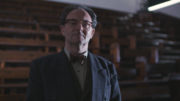In 1943 Prof Erwin Schrödinger gave a series of lectures in Trinity College Dublin entitled “What is Life?”. It would lead to one of the greatest developments in modern science. 75 years on from those momentous lectures, Ireland’s Prof Luke O’Neill, a world-leading Immunologist has some questions. Who was Erwin Schrödinger? What was the impact of his work? And how on earth did a Nobel prize winning physicist end up in Ireland just before the outbreak of WWII?!
Schrodinger’s arrival in Ireland began with Taoiseach Eamon De Valera who had a lifelong love of mathematics and wanted to open an institute specialising in Celtic Studies and Theoretical Physics along the lines of Princeton in the USA. After much effort Dev succeeded and the Dublin Institute of Advanced Studies opened on Merrion Square. It was only the second such institution in the world. Now he needed someone to run it and he looked to Europe to find his man.
Erwin Schrödinger was already a world famous physicist of the golden age which had produced Einstein, Plank and Bohr. In 1933 he won the Nobel Prize for an equation which revolutionised the understanding of the seemingly bizarre behaviour of tiny particles known as Quantum physics – It was described by Einstein as springing from “true genius”. He was working in Berlin in the 1930s when the rise of Hitler’s Nazi Party made his position untenable. Though not Jewish himself he was considered politically unreliable and he was forced to leave the country. Thus Schrodinger gladly accepted De Valera’s timely invitation and came to Dublin as DIAS’s first director of theoretical physics.
Schrodinger had one unusual aspect to his personal life which De Valera either didn’t know about or chose to ignore. He arrived in Ireland with his wife and his mistress (along with the child he had with the latter) and they set up home together. Apparently Schrodinger took well to life in Dublin, living in Clontarf, cycling in to his work in Merrion Square. He regularly attended the theatre which he had always loved. He often mixed with the literary and artistic sets in town and was on friendly terms with writers such as Myles na cGopaleen. He also kept in touch with his fellow scientists around the world and even tried to entice Albert Einstein to live in Ireland!
Despite his Nobel Prize Schrodinger is today perhaps more famous for his thought experiment involving a cat. Essentially he imagined a scenario where a cat is placed in a sealed box with a potentially lethal poison. Because we couldn’t know for certain if the cat was alive or dead until you opened the box you could theoretically say that the cat was both alive and dead at the same time. It was intended to highlight the absurdity at the heart of Quantum Mechanics but has ironically instead become the thing with which he is most associated!
While he was in Dublin Schrodinger, like other physicists internationally, began to look outside his own field and to take a growing interest in the area of genetics and heredity. In 1943 he delivered a series of lectures in Dublin that would lead to one of the greatest developments in modern science. Crick, Watson and Wilkins had all read Schrodinger’s lectures which were published in book form called “What is life?” and they were all inspired by him to look closer at the structure of DNA. Ultimately they discovered was it took the form of a double helix – a revolutionary discovery which would win them the Nobel prize in 1963.
Erwin Schrodinger influenced generations of scientists to ‘think outside the box’ and now in 2018 in Dublin played host to a gathering of the greatest minds from all disciplines (chemistry, biology, physics, philosophy) who came together to consider the next big questions of our era. Luke meets with some of the Nobel Prize winners to find out how Schrodinger influenced them and what they feel are the next great challenges to researchers around the world.




